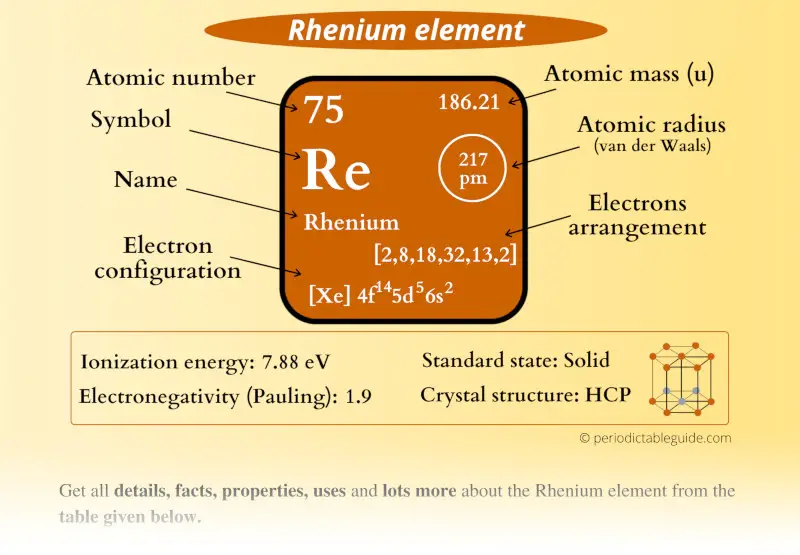
This is a SUPER easy guide on Rhenium element.
In fact, the table mentioned below is the perfect information box (Which gives you every single detail about the Rhenium element in Periodic table.)
So if you want to know anything about Rhenium element, then this guide is for you.
Let’s finish this very quickly.
Rhenium Element (Re) Information
| Appearance | 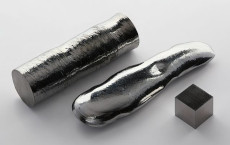 Silvery gray luster |
| State (at STP) | Solid |
| Position in Periodic table | 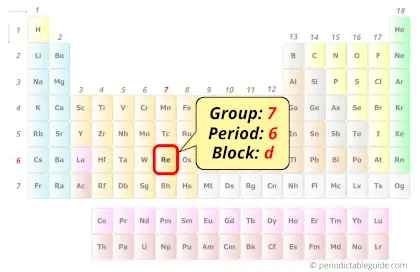 Group: 7, Period: 6, Block: d |
| Category | 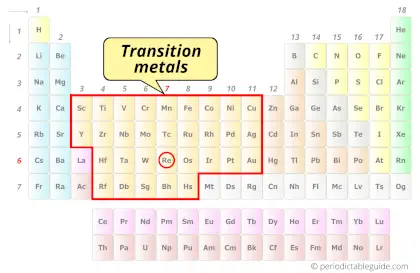 Transition metals |
| Atomic number or Protons | 75 |
| Neutrons | 111 |
| Electrons | 75 |
| Symbol | Re |
| Atomic mass | 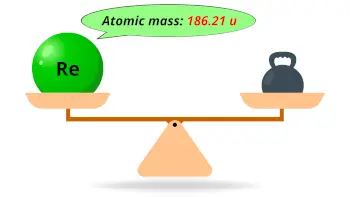 186.21 u |
| Electrons arrangement or Bohr model | 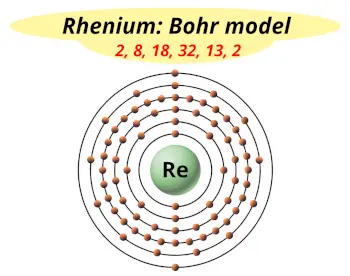 2, 8, 18, 32, 13, 2 |
| Electronic configuration | [Xe] 4f14 5d5 6s2 |
| Atomic radius | 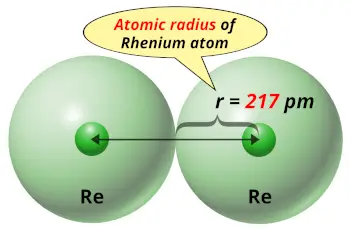 217 picometers (van der Waals radius) |
| 1st Ionization energy | 7.88 eV |
| Electronegativity | 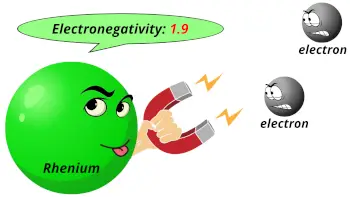 1.9 (Pauling scale) |
| Crystal structure |  HCP (Hexagonal close packed) |
| Melting point | 3459 K or 3186 °C or 5767 °F |
| Boiling point | 5903 K or 5630 °C or 10170 °F |
| Density | 21.02 g/cm3 |
| Main isotope | 187Re |
| Who discovered Rhenium and when? | Otto Berg, Walter Noddack, Ida Noddack (in 1925) |
| CAS number | 7440-15-5 |
Rhenium in Periodic table
Rhenium element is in group 7 and period 6 of the Periodic table. Rhenium is the d-block element and it belongs to transition metals group.
| H | He | ||||||||||||||||
| Li | Be | B | C | N | O | F | Ne | ||||||||||
| Na | Mg | Al | Si | P | S | Cl | Ar | ||||||||||
| K | Ca | Sc | Ti | V | Cr | Mn | Fe | Co | Ni | Cu | Zn | Ga | Ge | As | Se | Br | Kr |
| Rb | Sr | Y | Zr | Nb | Mo | Tc | Ru | Rh | Pd | Ag | Cd | In | Sn | Sb | Te | I | Xe |
| Cs | Ba | La* | Hf | Ta | W | Re | Os | Ir | Pt | Au | Hg | Tl | Pb | Bi | Po | At | Rn |
| Fr | Ra | Ac** | Rf | Db | Sg | Bh | Hs | Mt | Ds | Rg | Cn | Nh | Fl | Mc | Lv | Ts | Og |
| *Ce | Pr | Nd | Pm | Sm | Eu | Gd | Tb | Dy | Ho | Er | Tm | Yb | Lu | ||||
| **Th | Pa | U | Np | Pu | Am | Cm | Bk | Cf | Es | Fm | Md | No | Lr |
←Move to: Tungsten (W) element – Periodic Table
→Move to: Osmium (Os) element – Periodic Table
Why is Rhenium in Period 6?
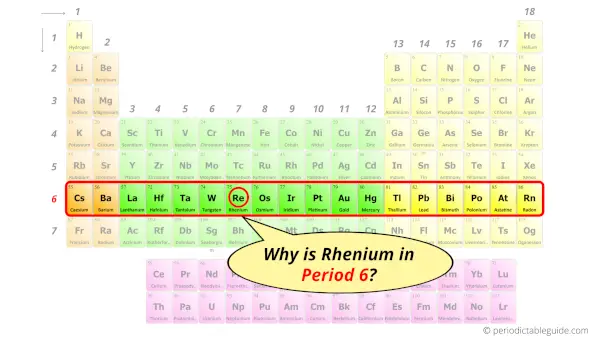
Let me ask you a question.
How many shells does a rhenium atom have?
It’s 6. Right?
You have already seen the bohr model of rhenium atom in the above table.
From the Bohr model, it can be found that the number of orbits or shells in rhenium is 6. Hence, as rhenium has 6 orbits, it lies in period 6 of the Periodic table.
Why is Rhenium in d-block?

Before knowing this reason, first of all I want to ask you a simple question.
How can you determine the blocks-wise position of elements?
The simple answer: The elements will lie in the s, p, d or f block will completely depend upon the subshell in which the last electron will enter.
For example; the electron configuration of rhenium is [Xe] 4f14 5d5 6s2.
So the last electron of rhenium enters the d-subshell or d-orbital.
Hence, rhenium is the d-block element.
Is Rhenium a Transition Metal? Why?
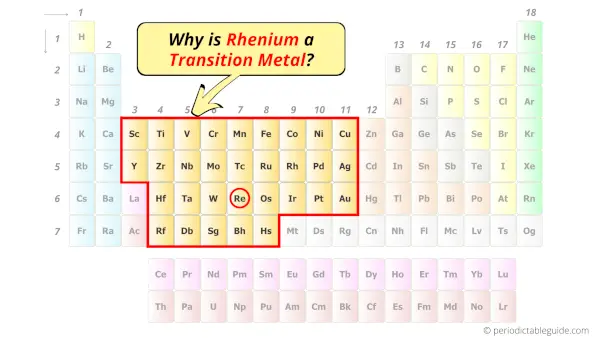
Yes, Rhenium is a transition metal because it has incompletely filled d-orbital in its ground state.
Let me explain the exact meaning of this.
According to the definition of transition metals;
The element should compulsorily have incomplete d-orbitals, either in their ground state (M) or most common oxidation states (M1+, M2+, etc) then only they are called transition metals.
Now, the ground state of Rhenium means its normal state in which it has neither gained nor lost any electron/s.
So the ground state of Rhenium is Re.
And the ground state electronic configuration of Rhenium is [Xe] 4f14 5d5 6s2.
In this state, if we see the electron configuration of Rhenium, then it possesses incomplete d-orbitals.

Because, there are only five electrons in the d-orbitals (here 5d orbitals).
In order to have the complete d-orbitals, there must be 10 electrons in it.
But in the ground state electronic configuration of rhenium, you can see that it has only 5 electrons in d-orbitals.
Thus, rhenium has incomplete d-orbitals.
And hence, as rhenium has incomplete d-orbitals, it is considered as a transition metal.
5 Interesting facts about Rhenium
Interesting facts about rhenium element are mentioned below.
- The name “Rhenium” was derived from the latin word “Rhenus” which means Rhine river of Germany.
- Rhenium was discovered by Otto Berg, Walter Noddack and Ida Noddack in 1925.
- The proportion of rhenium in the earth’s crust is very rare. It is only 7 parts per billion by weight.
- Rhenium is the 4th most dense element out of all the elements of periodic table.
- The annual production of rhenium in the entire world is around 40 to 50 tons only. And the majority of rhenium ores are found in Chile.
Properties of Rhenium
The physical and chemical properties of rhenium element are mentioned below.
Physical properties of Rhenium
Physical properties of rhenium are mentioned below.
- Rhenium is a solid metal having silvery grey metallic lustre.
- The melting point of rhenium is 3186 °C and its boiling point is 5630 °C.
- The atomic mass of rhenium is 186.21 u and its density is 21.02 g/cm3.
- The crystal structure of rhenium is HCP (hexagonal close packed).
- There are many isotopes of rhenium, but out of those isotopes, the main isotope is 187Re (which has an abundance of approximately 62%).
Chemical properties of Rhenium
Chemical properties of rhenium are mentioned below.
- Rhenium is resistant to corrosion and it tarnishes slowly in the air.
- At room temperature, rhenium does not react with alkalis and dilute acids.
- Rhenium has incomplete d-orbitals, and hence it is classified as a transition metal on the periodic table.
Uses of Rhenium
Uses of rhenium are mentioned below.
- Rhenium is used as an alloying element which provides strength and high temperature resistance to the alloy.
- The alloy containing rhenium is used in parts of jet engines.
- Rhenium is used as a catalyst along with platinum. This rhenium-platinum catalyst is used in production of high-octane gasoline.
Explore our New Interactive Periodic Table (with Rotating Bohr Models and More)

Details about this Periodic table:
- Access detailed info on all elements: atomic mass, electron configurations, charges, and more.
- View rotating Bohr models for all 118 elements.
- Get a free HD image of the Periodic Table.
Note: For future use, bookmark this Periodic table or visit “PeriodicTableGuide.com”
External resources:
- Rhenium – Element information, properties and uses | Periodic Table. (n.d.). Rhenium – Element Information, Properties and Uses | Periodic Table. https://www.rsc.org/periodic-table/element/75/rhenium
- Rhenium – Wikipedia. (2011, May 25). Rhenium – Wikipedia. https://en.wikipedia.org/wiki/Rhenium
- P. (n.d.). Rhenium | Re (Element) – PubChem. Rhenium | Re (Element) – PubChem. https://pubchem.ncbi.nlm.nih.gov/element/Rhenium
- It’s Elemental – The Element Rhenium. (n.d.). It’s Elemental – the Element Rhenium. https://education.jlab.org/itselemental/ele075.html
- C&EN: IT’S ELEMENTAL: THE PERIODIC TABLE – RHENIUM. (n.d.). C&EN: IT’S ELEMENTAL: THE PERIODIC TABLE – RHENIUM. https://pubsapp.acs.org/cen/80th/rhenium.html?
